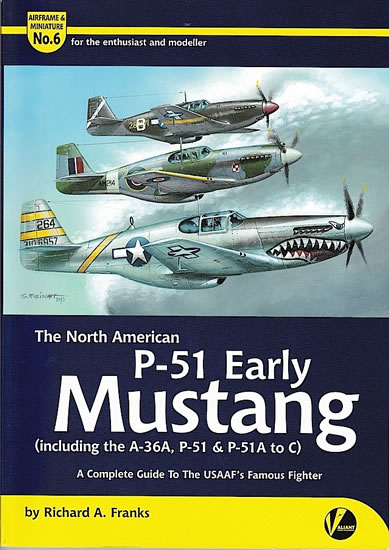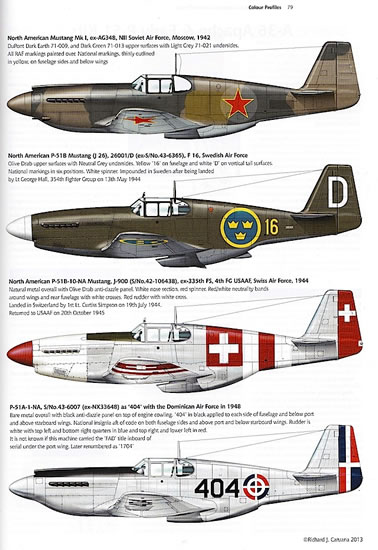The North American
P-51 Early Mustang
(including the A-36A, P-51 and P-51A to C)
A Complete Guide to the USAAF’s Famous Fighter
by Richard Franks

Valiant Wings Publishing
Airframe and Miniature No.6
S u m m a r y |
| Publisher and Title: |
Valiant Wings Publications – Airframe and Miniature No.6
The North American P-51 Early Mustang (including the A-36A, P-51 and P-51A to C) – A Complete Guide to the USAAF’s Famous Fighter
by Richard Franks |
| ISBN: |
978-0-9575866-1-1 |
| Media: |
Soft cover; A4 format; 208 pages; black and white and colour drawings and photographs; 14 fold-out pages of plans. |
| Price: |
£18.95 plus postage available online from Valiant Wings |
| Review Type: |
First Read |
| Advantages: |
Explains a complicated subject clearly and thoroughly; well written and illustrated with high production values.. |
| Disadvantages: |
|
| Conclusion: |
This sixth Airframe and Miniature volume maintains the high standards of earlier books in the series. Not everyone will agree with every fact as presented, but that’s not the point. What the book provides, and provides well, is a structure through which early P-51 variants are described and compared from a number of different perspectives. It will definitely be on my workbench when I start my next Allison- or early Merlin-engined P-51 build – highly recommended. |
Reviewed by Brad Fallen

HyperScale is proudly supported by Squadron.com
After tackling early Bf 109s in the fifth Airframe and Miniature book, for their next book author Richard A. Franks and publisher Valiant Wings have turned to the equally ambitious subject of early P-51s. As with the Bf 109 it's the later versions of the Mustang, particularly the P-51D, that have embedded themselves in public consciousness.
The earlier versions through which North American Aviation refined the type are less well known, with the differences between and nomenclature used to describe these versions a continuing source of discussion amongst aircraft enthusiasts and modellers alike.
Franks approaches this charged subject using the structure that has served him well in previous Airframe and Miniature volumes. The first of the book's three sections focuses on airframe development, using black and white profiles, period photos and bullet-point descriptions to highlight the defining characteristics of each version. These include subtle differences in armament, carburettor intake, cooling scoop, landing lights, and propeller type that in some cases were mixed and matched between individual airframes.
The airframe section is broken down into five chapters as follows:
- Evolution – NA-73X and Mustang Mk.I – describes the NA-73X prototype, the first 620 Mustang Mk.Is produced for the RAF, and the two XP-51s (NA-73 and NA-83) delivered to the USAAC from this production batch. The last two machines were testbeds and underwent a number of configuration and marking changes, which are covered in detail.
- P-51, A-36, P-51A and Mustang Mk.II. This chapter categorises the balance of Allison-engined Mustang types – not a straightforward task given the number of versions produced, some like the F-6B in low numbers. There were also variations depending on the operating service (RAF or USAAF) and the theatre to which they were deployed. Field modifications were common, for example in relation to the type of radio equipment fitted.
- The early Merlin-powered Mustangs – details the five Mustang Mk.Xs tested with Merlin 61 or 65 engines, the two XP-51Bs tested with Packard-built Merlins, and the two lightweight Mustang Mk.IIIs (FX858 and FX901) before covering the nearly 4,000 P-51B/Cs and derivatives manufactured. Modifications introduced during production are highlighted, and this chapter will be invaluable to anyone trying to unpick the differences between USAAF P-51B/Cs and RAF Mustang Mk.IIIs.
- Test Airframes, Conversions and Projects. This chapter catalogues the P-51 airframes used for aerodynamic, gunnery, ordnance, ski undercarriage, camera, ferry and drop tank, propeller, and target tug equipment trials. It also describes the twin-seat conversions carried out on an unknown number of P-51Bs and Cs in the field, and the Flying Test Bed project that saw a Merlin engine mounted mid-fuselage and driving a three-blade contra-rotating Rotol propeller; the project as cancelled in early 1945. The only typographic error I found was in this chapter, with the word 'Vickers' misprinted as 'Viskers' in one of the captions.
- Camouflage and Markings – outlines the evolution of P-51 camouflage in RAF and USAAF service using a chronological, theatre-by-theatre approach. More than two pages are devoted to a full colour guide to USAAF unit identification colours and markings. The Mustangs operated by eight foreign users are described, and there is a useful section that illustrates and describes the operational markings applied to P-51s.
- Colour profiles – eight pages of full colour port profiles, covering six Mk.Is, one Mk.Ia, one Mk.II, five Mk.IIIs, one A-36A, one P-51, four P-51As, 12 P-51Bs, one P-51C and one F-6C. Accompanying text includes a description of the camouflage and markings of each aircraft, and information about the pilot where this is known.
The next section of the book is dedicated to modelling the early P-51, with the chapters continuing as follows:
- A-36 Apache and Early P-51-series kits. Libor Jekl builds 1/72 kits from Condor (A-36A), Academy (Mustang Mk.IA), and Revell (Mustang Mk.III), while Steve Evans builds ICM’s 1/48 P-51C and Italeri’s 1/48 A-36A. All of the builds have been photographed on a step-by-step basis and are accompanied by clear explanatory text. Even if you don’t plan on building any of the subject kits, you will find tips here to enhance both your P-51 and general modelling skills.
- Building a Collection. This chapter uses 80 greyscale drawings to highlight the differences between early P-51 variants and, where necessary, airframes. It’s an invaluable resource for anyone embarking on a P-51 modelling project, or who just wants to know (for example) how each of the Mustang Mk.X airframes differed from one another.
- In Detail – another excellent modelling resource, and at 31 pages the longest chapter in the book. Using a combination of period and modern photos and technical drawings, this chapter provides walkaround details for most early Mustang variants.
Next come three appendices that demonstrate the popularity of the early P-51s as modelling subjects: a kit list (three pages long), an accessory list (also three pages), and a decal list, which runs to a whopping nine pages. A bibliography of relevant books is also provided, before the book concludes with an eight-page fold-out of 1/48 plans for the Mustang Mk.I, A-36, and P-51B/C.

Subject matter aside, the book has been well produced with clearly printed photographs and text and – importantly for a book that will be propped open on workbenches – robust binding that doesn’t look like it will give way any time soon.
This sixth Airframe and Miniature volume maintains the high standards of earlier books in the series.
I’m sure that not everyone will agree with every fact as presented, but that’s not the point. What the book provides, and provides well, is a structure through which early P-51 variants are described and compared from a number of different perspectives. It will definitely be on my workbench when I start my next Allison- or early Merlin-engined P-51 build, growing dog-eared as I flick from one bookmarked section to the next looking for that essential image or snippet of information.
Hopefully before too long we’ll see a companion volume on the later P-51 variants….
Highly recommended.
Thanks to Valiant Wings Publishing for the sample.
Review Copyright © 2014 by Brad Fallen
This Page Created on 30 May, 2014
Last updated
30 May, 2014
Back to HyperScale Main Page
Back to Reviews Page

|
